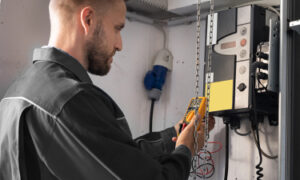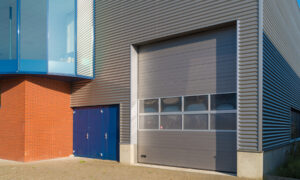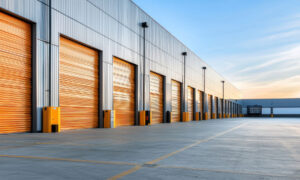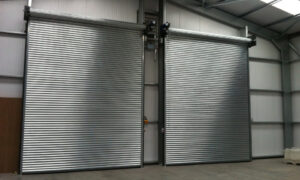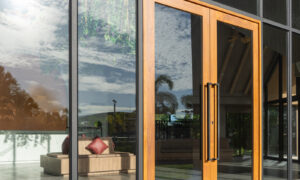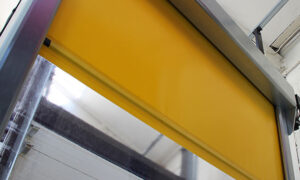Internal fire doors and external fire exit doors are fire safety essentials. These doors help to prevent the spread of fire while allowing personnel to escape your business premises quickly and easily.
But should fire doors be locked? And can you prop open a fire door? When it comes to commercial and industrial doors, it’s important to know the answers to questions like these. Get it wrong and you risk the safety of your staff. You could also face fines and penalties.
Here, we tackle some commonly asked fire door questions, helping you stick to regulations and keep employees safe.
Should fire doors be locked?
Fire exit doors should never be locked in a way that prevents people from quickly and easily exiting the building in an emergency.
Fire exit doors are lockable from the outside. But this lock is overridden when someone opens the door from the inside. There are various opening mechanisms to choose from, including:
- A panic bar — also called a push bar or crash bar.
- An emergency push pad — which has a small pad instead of a long, horizontal panic bar.
- A maglock — which has keypad access outside and a green, quick-release button inside. You can hardwire these locks into your alarm system. That way, they automatically release if the fire alarm system activates or if the power supply fails.
People shouldn’t need a key to unlock the door from the inside. So you shouldn’t keep fire doors locked with additional chains or padlocks.
However, if your building is unoccupied — for example, overnight when all personnel are at home — you can add extra locks to the door. These locks must be removed by the first person to arrive at the building each day.
Internal fire doors rarely need to be locked. However, if you have a fire door that forms part of your emergency exit route and provides building security, you need to choose locks that open from the inside without a key.
Can you prop open a fire door?
Internal fire doors should never be propped open. When you wedge or prop open a fire door, it can’t perform its function in case of a fire. Fire and smoke can move through a building unchecked.
Wedging or propping a fire door is illegal. It puts people at risk. It risks invalidating your insurance. A wedged door can also lead to hefty penalties and fines.
However, you can prop open a fire exit door. You just need to consider the risk this poses to business security.
Why is it important to keep fire doors closed?
Fire exit doors provide quick and easy escape in the event of a fire. The only thing you need to consider when opening these external doors is the security of your premises and personnel.
But internal fire doors are different. These doors provide passive fire protection. They help to prevent the spread of fire and smoke around a building, giving people enough time to escape safely.
Internal fire doors are made from fire-resistant materials. They have fire-resistant hinges and — in some cases — fire-resistant glass.
Fire doors also have intumescent strips around the sides and top of the door. When these strips experience heat, they expand to create a tight seal between the door and the frame. This seal contains smoke and fire.
Fire doors have different fire ratings based on the amount of time they can resist fire and smoke. You can get fire doors with the following ratings:
- FD30 — offering 30 minutes of fire resistance
- FD60 — offering 60 minutes of fire resistance
- FD90 — offering 90 minutes of fire resistance
- FD120 — offering 120 minutes of fire resistance
None of these fire-resistant and fire-containing features work if a fire door is left open. That’s why it’s so important to keep fire doors closed.
Is there a way to keep a fire door open safely?
Sometimes, it’s tempting to keep an internal fire door open. Open doors allow personnel to move more easily around the building. They also allow fresh air to circulate.
As we’ve already mentioned, propping or wedging open a fire door is incredibly dangerous — and illegal. However, there are some ways to keep a fire door open safely.
You can use a fire door holder or retainer as part of your fire door system. These mechanisms hold doors open but automatically release them in the event of a fire.
Door holders and retainers can be triggered by the sound of a smoke alarm. Some are wired into the fire alarm system and are triggered when power to the holder or retainer is cut.
Self-closing fire doors like these are the only fire doors that you can safely leave open. But — like all fire doors — it’s important that nothing obstructs the door and prevents it from closing.
Is a blocked fire door ok?
No. A blocked fire door won’t close properly. This means it can’t form a seal and can’t prevent the spread of fire and smoke.
A blocked fire exit door also poses serious problems. Blockages prevent personnel from existing your business premises quickly and easily in the event of a fire. You should make it as easy as possible for people to escape the building by keeping fire doors clear of any obstruction.
In summary
We hope this post has cleared up your questions about how to use fire doors and fire exit doors safely. Here’s a quick summary of what we’ve covered:
Internal fire doors should never be propped or wedged open. They should remain clear of obstructions and should only be left open if you have doors that self-close in the event of a fire.
Fire exit doors can be wedged and propped open but locking these doors is a problem. People need to be able to exit these doors instantly, without needing a key.
If you want any more advice on fire safety for your business — or need fire door installation, maintenance or repairs — contact the team at Secure Door Systems today.

